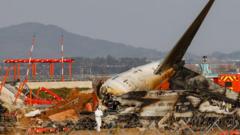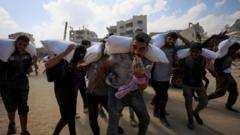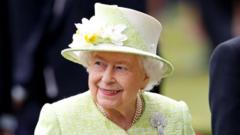Did Pilot Error Really Cause the Jeju Air Crash? Families Demand Answers!

An In-Depth Analysis of the Jeju Air Plane Crash Investigation
The tragic crash of Jeju Air Flight 2216 on December 29, 2022, has left an indelible mark on South Korea, being the deadliest aviation disaster in the country's history. With an investigation that has stirred significant controversy, recent findings indicate that the pilot mistakenly shut down the wrong engine. This article delves into the critical details of the crash, the impact on victims' families, and the broader implications for aviation safety in South Korea.
Overview of the Incident
On that fateful morning, Jeju Air Flight 2216 was preparing to land at Muan International Airport when a bird strike occurred. The pilots issued a mayday call and attempted to land the aircraft from an alternate direction. Unfortunately, the landing turned catastrophic when the plane made a belly landing without deploying its landing gear, subsequently skidding into a concrete barrier.
The Aftermath: Casualties and Immediate Reactions
Out of 181 individuals on board, only two survived, underscoring the tragedy of the situation. The crash prompted immediate responses from South Korea's transport ministry, which committed to removing concrete barriers at seven airports to enhance safety measures. Families of the victims have since expressed their outrage over the investigation's findings.
The Investigation Findings
As the investigation by South Korea's Aviation and Railway Accident Investigation Board unfolded, it revealed that the pilot had mistakenly shut down the left engine, which was functioning normally. Instead, the right engine, severely damaged by the bird strike, should have been shut down. This misjudgment has sparked a heated debate about pilot training and the overall safety protocols in place.
Criticism from Victims' Families
Families of the victims voiced their dissatisfaction with the investigation's focus on pilot error. They argue that the report failed to adequately address other critical factors contributing to the crash, particularly the presence of the concrete barrier. Their call for a more comprehensive examination highlights the emotional toll of the tragedy and raises questions about accountability in aviation safety.
Response from Pilots’ Union
The Jeju Air pilots' union also weighed in on the findings, criticizing the report for its narrow focus on the pilot's decision-making. They argue that systemic issues within the airline and regulatory bodies should also be scrutinized to prevent future disasters. This perspective emphasizes the importance of understanding the broader context of aviation safety and pilot support systems.
Implications for Aviation Safety
The Jeju Air crash has sparked discussions about aviation safety protocols in South Korea and around the world. The incident highlights the need for ongoing training and support for pilots, especially in emergency situations. Beyond pilot training, the design and positioning of airport infrastructure, such as barriers, must be reevaluated to prevent future accidents.
Regulatory Changes Following the Crash
In response to the crash, the South Korean transport ministry announced plans to remove concrete barriers at multiple airports. This decision reflects a commitment to enhancing safety measures and demonstrates awareness of the need for more stringent regulations in airport design. The recommendations coming from the investigation could lead to significant changes in how airports are constructed and maintained.
Global Perspective on Aviation Safety
The Jeju Air crash is not an isolated incident; it fits into a broader pattern of aviation accidents that have raised concerns worldwide. Other countries have also experienced similar tragedies, prompting regulatory bodies to implement stricter safety measures. Lessons learned from such incidents can inform global standards for pilot training, emergency preparedness, and airport design.
Conclusion: A Call for Comprehensive Safety Reforms
The heartbreaking events surrounding the Jeju Air Flight 2216 crash serve as a stark reminder of the need for comprehensive safety reforms in the aviation industry. As investigations continue, it is crucial for all stakeholders—regulatory bodies, airlines, and families of victims—to engage in transparent discussions aimed at enhancing safety protocols. Each life lost is a reminder of the responsibility that comes with aviation, and it is imperative that lessons from this tragedy lead to meaningful change.
FAQs About the Jeju Air Plane Crash
What caused the Jeju Air plane crash?
The crash was primarily caused by the pilot mistakenly shutting down the wrong engine, which led to a catastrophic landing after a bird strike.
How many people died in the Jeju Air crash?
Out of 181 passengers and crew members on board, 179 tragically lost their lives, making it the deadliest plane crash in South Korea's aviation history.
What actions are being taken to improve aviation safety in South Korea?
In response to the crash, the South Korean transport ministry has announced plans to remove concrete barriers at various airports and is reviewing safety protocols to prevent similar incidents in the future.
This tragic incident serves as a crucial learning point for the aviation industry, emphasizing the need for continuous improvement in safety measures. How can we ensure that lessons from this tragedy lead to actionable changes in aviation safety? #AviationSafety #JejuAir #Flight2216
Published: 2025-07-21 09:54:02 | Category: world



